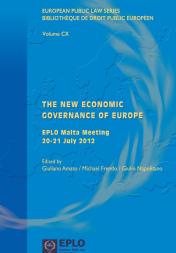
Administrative Law / Droit administratif
2007
Spain / Espagne
Luis F. Maeso Seco
Profesor Asociado del Área de Derecho Administrativo de la Universidad de Castilla-la Mancha
The year 2007 has been particularly productive in relation to the adoption of administrative laws. In fact, more or less, about ten of them - ordinary and organic - concerning the most diverse sectors of the Spanish Administrative Law, have been approved in the last twelve months. However, due to the brevity that must accompany this chronicle, it has been impossible to comment every law in the preceding pages. However, this fact has not impeded us from making a brief comment on the most important contents of two of them, that is: 1) Law 7/2007 of the 12th of April, on the Public Service Basic Statute; and 2) Law 26/2007 of the 23rd of October, regulating the Environmental Responsibility. The selection of these two laws as a subject of comment of our chronicle has not been accidental but it has resulted from the fact that both can be qualified as significant legal innovations. In the case of Law 7/2007 of the 12th of April, its importance results from the fact that it has created, in our legal administrative system - after almost a century and for the first time since the adoption of our Constitution -, a regulation allegedly common for all public servants. A regulation formally and materially at the top of the entire system, even if we can consider it minimal. A regulation whose purpose is triple: a) to provide effective application of Article 149.1.18a of the Spanish Constitution, b) to adapt the model of public employment to new social demands and requirements (effectiveness, efficiency and quality), derived from the global administrative modernization, and c) to take into due consideration the autonomic fact. On the other hand, Law 26/2007 of the 23rd of October is equally fundamental taking into account that, through it, a new public system of environmental responsibility, objective and unlimited, until now non-existent, is being formed. A system wishing to resolve the problems and dysfunctions provoked by the precedent regulation of civil environmental responsibility (subjective and limited). In any case, it must be taken into consideration that these two laws have been adopted lately and that many of their provisions must be the object of subsequent development for other norms (either of legal or regulatory character). So, we will have to wait for some time to see if its undoubted theoretical significance duly corresponds to the so-called effective application of its contents.
El año 2007 ha resultado ser especialmente fructífero en lo que a la aprobación de leyes administrativas se refiere. De hecho, una decena larga de normas de rango legal - ordinario e incluso orgánico -, concernientes a los más diversos sectores del Derecho Administrativo español, han visto la luz en estos últimos doce meses. Sin embargo, y debido a la obligada brevedad que debe acompañar a esta crónica, nos ha resultado imposible dar cuenta de todas y cada una de ellas en las páginas precedentes. Ahora bien, al mismo tiempo, ello no nos ha impedido efectuar, cuando menos, un breve comentario de los contenidos más destacados de dos de ellas, a saber: 1) la Ley 7/2007, de 12 de abril, del Estatuto Básico del Empleado Pública; y 2) la Ley 26/2007, de 23 de octubre, reguladora de la Responsabilidad Medioambiental. Dos leyes cuya elección como objeto de comentario de nuestra crónica no ha sido casual, sino que ha obedecido, en cambio, al hecho indiscutible de que ambas pueden ser calificadas como trascedentes innovaciones jurídicas. En el caso de la Ley 7/2007, de 12 de abril, su transcendencia es fruto de que, en su virtud, se instaura en nuestro sistema jurídico administrativo - después de casi un siglo y por vez primera desde que se aprobara la Constitución - un estatuto que se pretende común para todos los servidores públicos. Un estatuto que, formal y materialmente, se convierte en cabecera del entero sistema y que puede considerarse de mínimos. Y un estatuto cuyo triple objetivo es el de: a) dar efectivo cumplimiento al artículo 149.1.18ª de la CE; b) adecuar el modelo de empleo público a las nuevas demandas y requerimientos sociales (eficacia, eficiencia y calidad), derivados de la modernización administrativa global; y c) tomar debidamente en cuenta el dato autonómico. Por su parte, la Ley 26/2007, de 23 de octubre, resulta igualmente trascendental, habida cuenta de que, a su través, se articula un sistema de responsabilidad ambiental público, objetivo e ilimitado, hasta ahora inexistente. Un sistema llamado a resolver los problemas y disfunciones que el régimen de responsabilidad ambiental civil (subjetivo y limitado) venía provocando. En cualquier caso, debido a que la aprobación de estas dos normas se ha producido hace escasas fechas y, así también, a que muchas de sus previsiones deberán ser objeto de desarrollo posterior por otras normas - de rango legal o reglamentario -, habrá que esperar todavía un tiempo para conocer si, en verdad, se da una adecuada correspondencia entre su indudable significación teórica y la pretendida virtualidad aplicativa de sus contenidos.





















